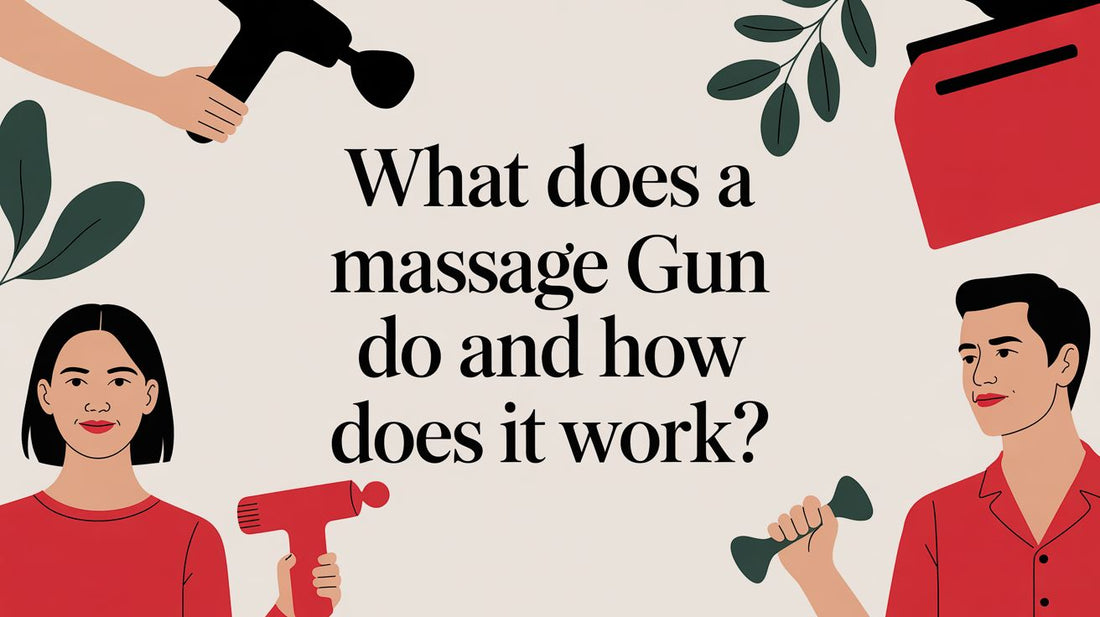
If you've ever wondered, what does a massage gun do?, you're in the right place. Think of it as your personal, on-demand deep-tissue massage therapist. It uses percussive therapy—rapid, concentrated pulses that reach deep into your muscle tissue—to help reduce soreness, support circulation, and improve your range of motion.
It’s a simple yet powerful tool for anyone looking to feel and move better.
Your Quick Guide to How Massage Guns Work
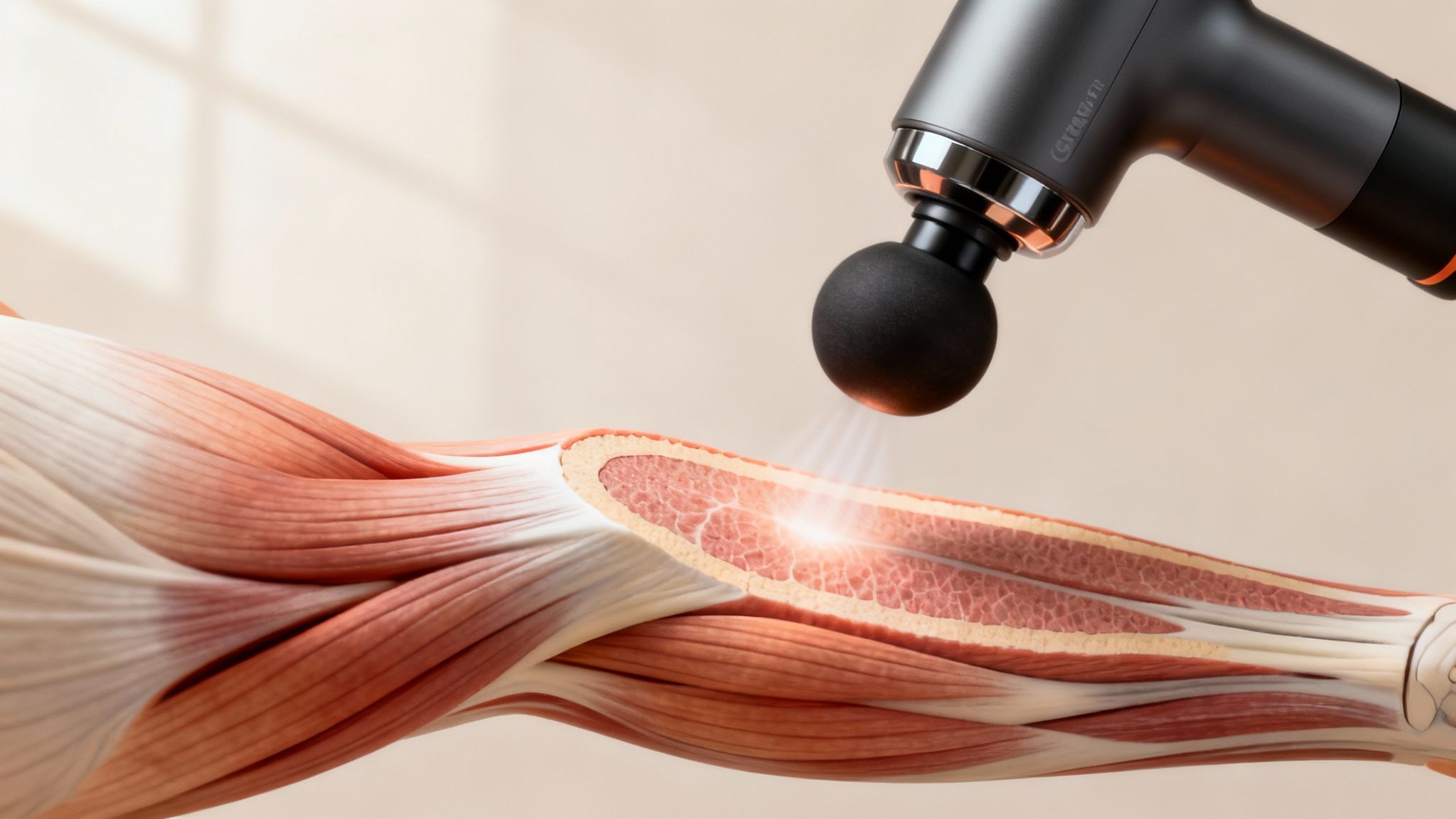
We've all been there—a stubborn knot in your shoulder after a long day or sore calves after a workout. A massage gun gets right to the source of that discomfort with rapid bursts of pressure, reaching far deeper than a foam roller or your own hands can.
This process helps release muscle tension and break up tough knots. It’s like having a pro-level recovery session ready whenever you need it, helping you work out the tightest spots and get your body ready for whatever's next. For anyone looking for effective at-home muscle relief, this is a game-changer.
Key Actions of a Massage Gun
This powerful tool fits right into any wellness routine, whether you're a serious athlete or just trying to shake off everyday stiffness. Here’s what a quality device like the Cryotex Massage Gun is built to do:
- Helps Reduce Muscle Soreness: By supporting blood flow to tired muscles, it helps calm that post-workout ache, often known as DOMS (Delayed Onset Muscle Soreness).
- Supports Flexibility: Percussive therapy helps release tightness in muscle tissue, which can contribute to a better range of motion over time.
- Promotes Recovery: It helps support your body’s natural repair process by delivering more oxygen and nutrients to your muscles.
Essentially, it puts a high-quality recovery experience right in the palm of your hand.
Massage Gun Effects at a Glance
To make it even simpler, here's a quick rundown of what a massage gun does for your body.
| Action | How It Helps Your Body |
|---|---|
| Percussive Pulses | Sends rapid vibrations deep into muscle tissue. |
| Increased Blood Flow | Delivers more oxygen and nutrients to sore areas. |
| Breaks Up Knots | Helps release tight muscle adhesions and trigger points. |
| Soothes Nerves | Can help calm the nervous system for overall relaxation. |
It’s a straightforward tool with impressive benefits for your everyday wellness.
So, How Does Percussive Therapy Actually Work?
Ever wonder how those rapid-fire pulses actually make your muscles feel better? The magic is in the science of percussive therapy—a process that works with your body's natural systems to bring you fast relief.
Think of a stubborn knot in your shoulder. The vibrations from a massage gun, like the powerful and quiet Cryotex model, act like a small tiller, helping to break up that dense, tight tissue. This mechanical action is the first step to releasing the tension that causes stiffness and discomfort.
It Goes Deeper Than the Surface
But the real work happens beneath the skin. As the massage gun gets to work, it helps kickstart blood flow to the area you're targeting.
This increased circulation is like opening up a superhighway for your body's repair crew. Fresh, oxygen-rich blood rushes in, delivering the nutrients your muscles need after a tough workout or a long day. This process is critical for supporting the healing of tiny muscle tears that are the true source of soreness.
At the same time, that increased circulation helps flush out metabolic waste, like lactic acid, that can build up and make you feel achy. It’s a one-two punch for promoting recovery.
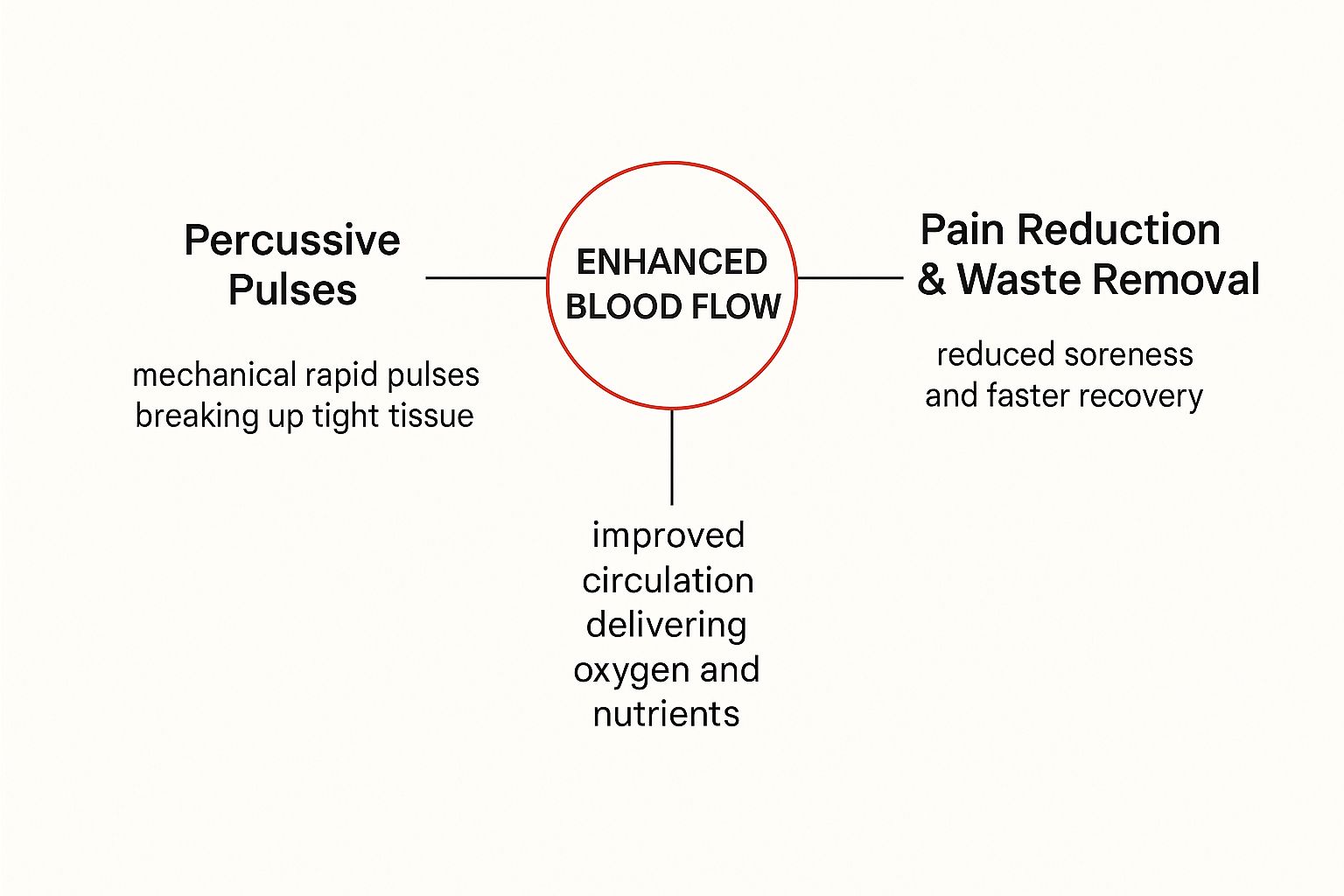
As you can see, the percussive pulses directly support circulation, which in turn can help reduce discomfort and speed up your body's recovery time.
Calming Down Your Nerves
There’s one more cool thing happening: the effect on your nervous system.
The quick, rhythmic vibrations can interrupt the discomfort signals your muscles are sending to your brain. This is based on a concept known as the Gate Control Theory of Pain. In simple terms, the gentle buzzing creates a competing sensation that distracts your brain from the ache, offering almost instant relief.
By working with your body from the inside out, percussive therapy turns a simple massage into a seriously powerful tool for wellness. You can even read more research on the percussion massage gun market to see how popular these devices have become.
Real-World Massage Gun Benefits for Every Body
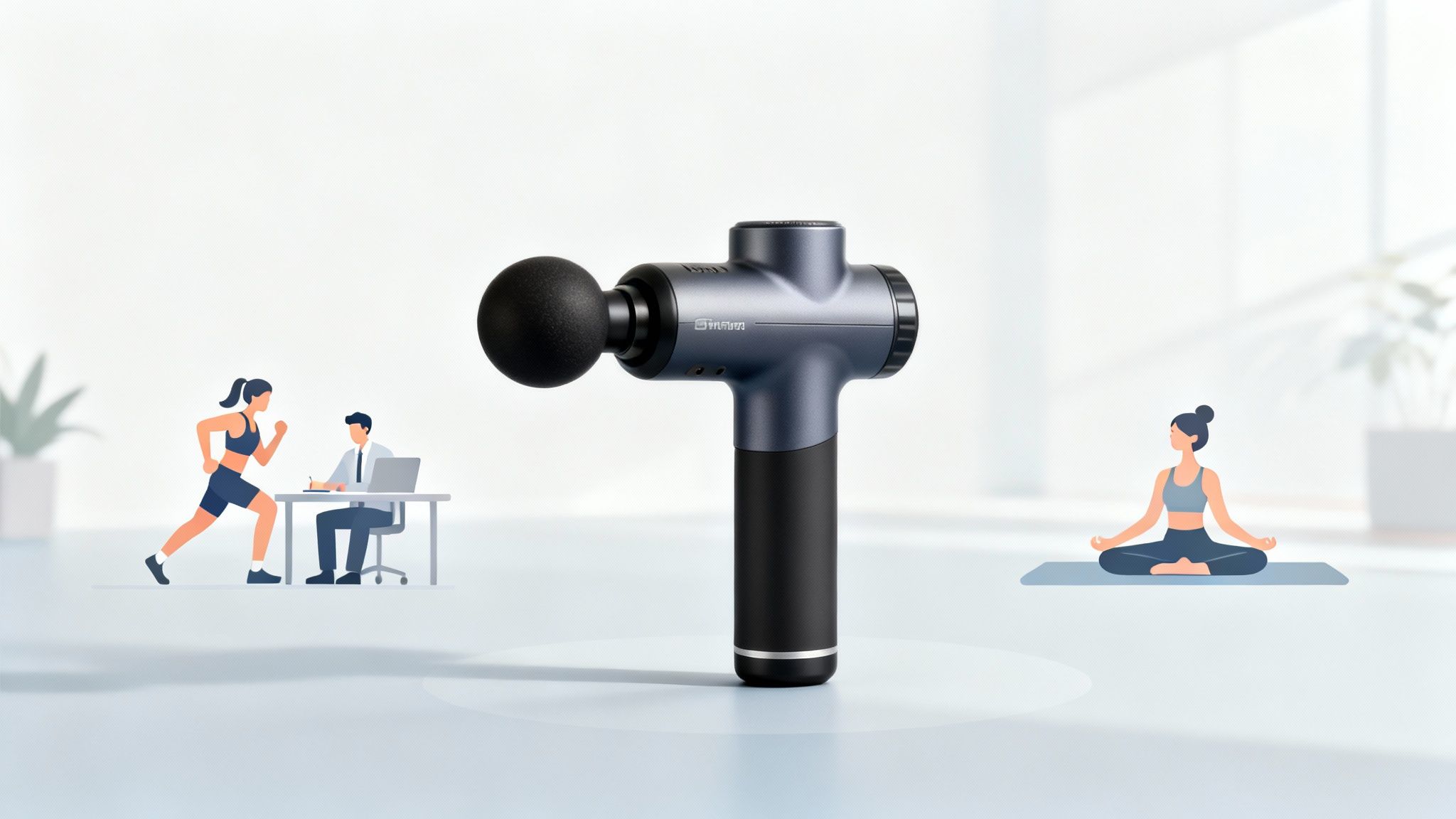
The science is cool, but let's get practical. What does a massage gun actually do for you in your daily life?
It’s simple: it delivers on-demand relief for just about everyone. Whether you’re an athlete, an office professional, or just trying to keep up with life, a massage gun is one of the most versatile tools you can own.
For the Dedicated Athlete
If you push your limits, you know that recovery is where progress happens. A massage gun is your secret weapon.
Using it after a tough workout helps lessen the intensity of delayed onset muscle soreness (DOMS). By boosting blood flow, it supports muscle repair so you can get back to training faster and with less stiffness. It's also fantastic for a pre-workout warm-up, helping to wake up your muscles so you're primed and ready to go.
“I’m a runner in Chicago, and my Cryotex has been a game-changer for my hips and calves. I feel less tight the next day and ready for my morning run.” - Jessica L.
For the Office Professional
Sitting for eight hours a day? Your neck, shoulders, and lower back are probably feeling it. A massage gun offers targeted relief exactly where you need it most.
Just a few minutes on those stubborn knots can help release the tension that builds up from poor posture and long hours at the keyboard. Think of it as hitting the reset button on workday stress. This simple routine can help you feel more relaxed, focused, and free from stiffness.
Want to learn how to tackle that pain head-on? We break it down in our guide on how to relieve muscle pain at home with the Cryotex Massage Gun.
For Everyday Wellness and Active Lifestyles
You don't have to be a marathon runner to feel the benefits. For anyone who wants to feel better day-to-day, a massage gun is a must-have.
- Improve Flexibility: Gently working over tight muscles helps them relax, which can support freer movement.
- Ease Common Aches: Perfect for soothing soreness after yard work, a long drive, or just a busy day on your feet.
- Promote Relaxation: The rhythmic pulses have a surprisingly calming effect on your entire nervous system.
It’s no wonder these devices have become so popular. The global percussion massage gun market is a testament to how effective they are for pain relief and overall wellness. Discover more insights on the percussion massage gun market here.
How to Use a Massage Gun Safely and Effectively
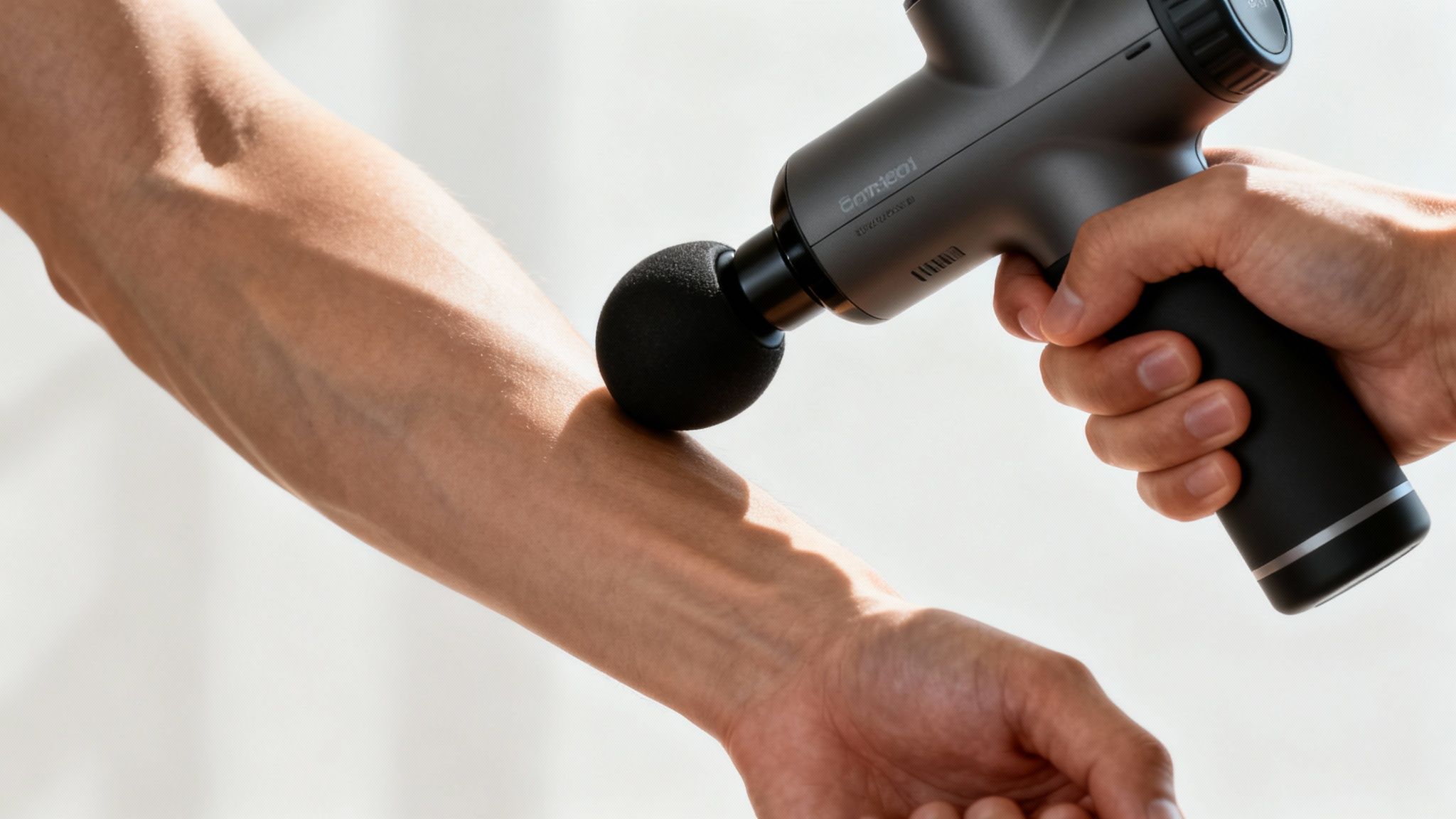
Knowing what a massage gun does is one thing, but using it correctly unlocks all its benefits. The good news? Getting started is easy once you know a few ground rules.
First, turn the device on before placing it on your body to avoid any sudden jolts. Then, let the head float over your muscles. There's no need to apply a lot of force—the percussive action is designed to do the work for you.
Getting Started The Right Way
For a session that’s both safe and effective, follow these simple steps. This method helps you get relief without causing irritation.
- Pick the Right Attachment: Start with an all-purpose head, like the large ball that comes with the Cryotex gun. It's great for big muscle groups like your quads, glutes, and back. For deeper knots, you can swap to a more targeted bullet or fork head.
- Start Low and Slow: Always begin on the lowest speed setting. This lets your muscles get used to the sensation and helps you find what feels good. You can always increase the intensity, but more power isn't always better.
- Keep It Moving: Gently glide the massage gun over the belly of the muscle using slow, sweeping motions. Avoid lingering in one spot for too long, as this can lead to soreness or bruising.
Key Safety Tips to Remember
While massage guns are generally safe, a few rules are non-negotiable. Following these guidelines will help you avoid common mistakes.
The goal is therapeutic relief, not pain. If you feel any sharp or shooting pain, stop immediately. A deep, gentle ache on a knot is usually fine, but real discomfort is your body’s signal to back off.
Keep these points in mind during every session:
- Avoid Bones and Joints: Never use the massage gun directly on bony areas like your spine, kneecaps, shins, or elbows.
- Time Your Sessions: Stick to 30–120 seconds per muscle group. A full-body session should not exceed 15 minutes.
- Steer Clear of Injuries: Do not use your gun on fresh injuries like sprains, strains, inflamed areas, or any broken skin.
To get the most out of your recovery routine, consider pairing your massage session with other therapies. For example, our hot and cold therapy wraps are perfect for reducing inflammation and soothing your muscles after a deep percussive treatment.
How to Choose the Right Massage Gun
Feeling lost in all the technical specs? Don't worry. Picking the right massage gun is simpler than it looks once you know what to focus on.
It’s all about matching the tool to your needs. The three big features to look at are stall force, amplitude, and speed.
Understanding the Key Features
Let’s quickly break down what these terms actually mean for your muscles.
- Stall Force: This is how hard you can push before the motor stops. If you’re an athlete with dense muscle, a higher stall force (40+ lbs) is needed for a truly deep massage. For everyday soreness, a more moderate force is sufficient.
- Amplitude: This tells you how deep the massage head travels into your muscle. An amplitude of 12–16 mm provides a deep-tissue experience, perfect for breaking up knots. A shorter amplitude (around 10 mm) is gentler and better for sensitive areas.
- Speed (RPMs): Most guns range from 1,800 to 3,200 percussions per minute (RPM). It's best to start low to warm up the muscle, then increase the speed to tackle stubborn knots. A model with several speed settings, like the versatile Cryotex Massage Gun, gives you the freedom to customize every session.
The goal is to match the power to your purpose. What works for an athlete's recovery is likely overkill for someone just looking to unwind after a long day.
There's a reason the massage gun market is growing—more people are realizing how powerful these at-home recovery tools are for both fitness and well-being. Learn more about the growing massage gun market.
Common Questions About Using a Massage Gun
We’ve covered what a massage gun does, but it’s normal to still have a few questions. Getting comfortable with any new wellness tool is key to making it a regular part of your routine.
To help you feel confident, we’ve put together straightforward answers to the most common questions we hear.

Can I Use a Massage Gun Every Day?
Yes, for most people, using a massage gun for 10-15 minutes a day is a fantastic way to manage muscle tightness and support recovery.
The golden rule is to listen to your body. If you feel any sharp pain or notice soreness getting worse, take a day or two off. As a general guide, stick to about two minutes per muscle group to avoid overdoing it.
Should Using a Massage Gun Hurt?
No, a massage gun should provide deep relief, not pain. You might feel some intensity on a stubborn knot—similar to a deep tissue massage—but it should always be a "good hurt."
If you feel real pain, you're likely pressing too hard, using too high a speed, or staying on one sensitive spot for too long. Always start on the lowest setting and let the gun float over your muscles.
What Is the Difference Between a Massage Gun and a Foam Roller?
Both are great recovery tools, but they do different jobs. A foam roller uses your body weight to apply broad, steady pressure, which is perfect for releasing tension across large areas like your quads or back.
A massage gun delivers targeted percussive therapy that gets deep into specific knots and trigger points. Think of a foam roller as a wide paintbrush and a massage gun as a fine-point pen for precision work.
When Should I Not Use a Massage Gun?
Safety first. Avoid using a massage gun on acute injuries like sprains, strains, or broken bones.
You should also steer clear of using it directly on:
- Bones and joints (like your spine or kneecaps)
- The front of your neck or throat
- Varicose veins or areas with poor circulation
If you are pregnant or have a medical condition like deep vein thrombosis (DVT), be sure to talk to your doctor before using any percussion massager.
Ready to feel the difference for yourself? At BestMassageGun.com, our mission is to make professional-level recovery accessible to everyone.
Shop the Cryotex Holiday Bundle — 4 FREE Turkish Towels
Article created using Outrank